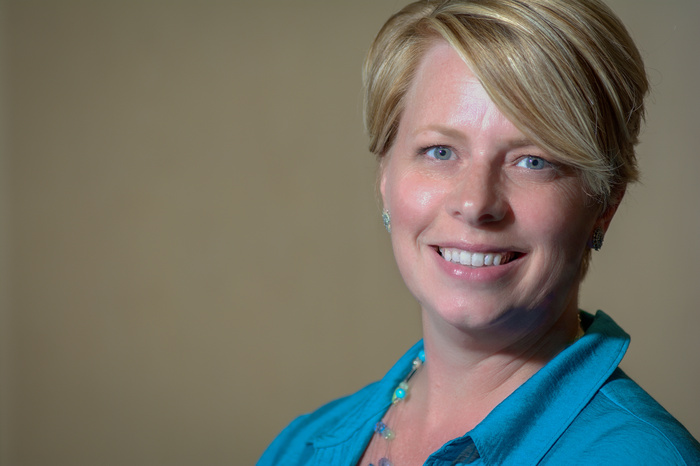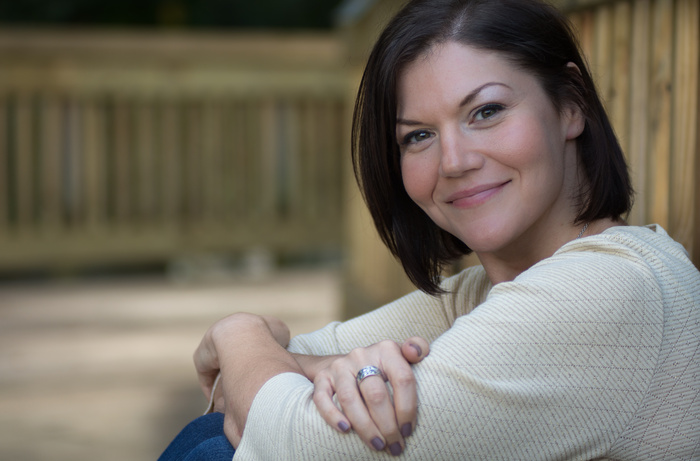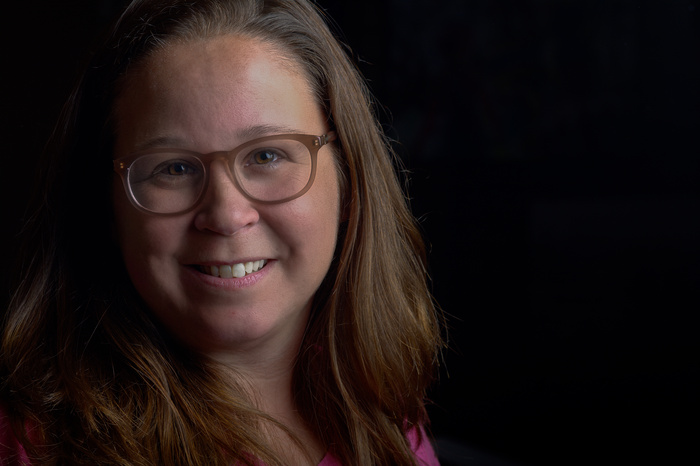Using the "Top Crop" in Head Shots
In: Portrait
What does the top of your head have to do with the impact of your headshot? Absolutely everything! When composing an image – or any image for that matter, a photographer should take into account the intended use of the image.
But before we can discuss the top of your subject’s head, it is necessary to first consider the background or setting for the photograph. Careful consideration of the background and setting for the image will affect the “message” of the image. Backgrounds have a variety of textures, colors and resulting feelings. The viewer will make assumptions about the person based upon the overall “feel” of the image. This means considering both the smooth solid colors of a studio background or the contextual background of an outdoor setting. Ask yourself “what does my client want me to say in this image?” The answer will tell you where and how to shoot. It means asking questions and getting to know your subject “outside of the viewfinder”. Your image may be the first and only impression the viewer has before making a decision. It means thinking about how your subject wishes to be seen visually to convey a verbal description.
In the world today, the photographer must realize that the headshot is also not just a photograph of someone’s head and shoulders - I think too many photographers miss the mark here. This type photograph is a personal brand – it is about YOUR CLIENT - not their clothing, their shoulders or anything else. This is how your client wants others to see them and it should be faithful to their appearance and their personality without heavy post processing.

So, as I said earlier; if the top of the head has absolutely everything to do with the impact of the shot, then why would I cut it off in the image above? Everyone knows that top of the head is there. The viewer does not assume that your head stops and is perfectly flat – in fact it never even enters the mind. A headshot is done for impact – here I am! – is what your client wants to say. This could be their first impression to a casting agent or the one that sits with your resume long after your interview. Shooting from different angles, moving the eyes higher in the frame and even the background selection all convey different things – colors do this too!
Amy was wearing a light blue shirt – light blue is a calm color and the earth tone of the selected background gives the feel of stability. By cropping the top of her head and putting her eyes at one of the four anchor points in a photograph – I have created a natural focal point to the image. The viewer’s eyes are always drawn towards the subject’s eyes first, which is why placing the most compelling point of a headshot (the subject's eyes) in that section will make the image stronger. In the resulting image I have crafted a focus on the eyes and through color, a feel of stability. The top crop of Amy’s head further pushes the viewer’s eyes down to connect with hers.
Lighting was done using a Photoflex FlexFlash 200w with a Photoflex RUD 30” Shoot Through Umbrella. I placed the flash at a 45° angle and slightly above her eye level to create a slight shadow on Amy’s face. I wanted a slightly stronger light, so rather than shooting through the umbrella, I shot into it bouncing the light back onto Amy.

In the next image, I wanted to show Carissa as comfortable, casual and relaxed. The camera sees all and we are always our own harshest critics, every model is different as is each photographer. It may take time to build a collaboration – so be patient. As I said earlier; clothing and background, convey a mood. In this image expression plays an active role as well.
The light brown of her sweater and the dark color of her hair needed to stand out from the background. Having her sit on a boardwalk with contrasting colors as well as a blurred background from a wide aperture, immediately puts the focus on her. Cropping the top of her head forces the viewer’s eye back down to Carissa’s eyes, if they start to wander away. I chose to have her arms are crossed on her knees to help the “comfortable” feel we were after. I wanted the viewer to feel as though they could be sitting with her just having a light conversation about anything. Placement of Carissa’s hand was important to achieving this feeling. Had I kept in inside of her arm, it may have felt like a barrier of sorts and created an uneasy feeling. By placing it outside, it creates a more inviting feel as if extending a hand in greeting. The location selection – outside on a boardwalk - gives the feel of a casual afternoon in the park, not the “planned” feel of a studio or the “busy” feel of an office.
Lighting was outdoor light - broken shade diffused through a Photoflex LitePanel.

Once again I have cropped the top of the head in this shot. Lori is a student of mine and an emerging photographer. The use of a black background achieved by lighting her only with a Photoflex Flex Flash 200w and a Photoflex Octodome, helps her emerge from obscurity - represented by the dark background. Using sidelight brings out the contours of facial features to give a little bit more information about her. Again, she makes eye contact with her eyes being placed using one of the photograph’s anchor points. The top crop of the image once again helps the viewer focus on her eyes.
A photographer must understand the use of negative space and creation of mood in each image. The standard business headshot is fine with just a head and shoulders, but as our skills evolve so must our understanding about crafting an image to present a message about our subject. We should be dictating how our viewer should look at the image and the feel they come away with. Your clients, when asking for a headshot, are asking you to do just that.
But before we can discuss the top of your subject’s head, it is necessary to first consider the background or setting for the photograph. Careful consideration of the background and setting for the image will affect the “message” of the image. Backgrounds have a variety of textures, colors and resulting feelings. The viewer will make assumptions about the person based upon the overall “feel” of the image. This means considering both the smooth solid colors of a studio background or the contextual background of an outdoor setting. Ask yourself “what does my client want me to say in this image?” The answer will tell you where and how to shoot. It means asking questions and getting to know your subject “outside of the viewfinder”. Your image may be the first and only impression the viewer has before making a decision. It means thinking about how your subject wishes to be seen visually to convey a verbal description.
In the world today, the photographer must realize that the headshot is also not just a photograph of someone’s head and shoulders - I think too many photographers miss the mark here. This type photograph is a personal brand – it is about YOUR CLIENT - not their clothing, their shoulders or anything else. This is how your client wants others to see them and it should be faithful to their appearance and their personality without heavy post processing.

So, as I said earlier; if the top of the head has absolutely everything to do with the impact of the shot, then why would I cut it off in the image above? Everyone knows that top of the head is there. The viewer does not assume that your head stops and is perfectly flat – in fact it never even enters the mind. A headshot is done for impact – here I am! – is what your client wants to say. This could be their first impression to a casting agent or the one that sits with your resume long after your interview. Shooting from different angles, moving the eyes higher in the frame and even the background selection all convey different things – colors do this too!
Amy was wearing a light blue shirt – light blue is a calm color and the earth tone of the selected background gives the feel of stability. By cropping the top of her head and putting her eyes at one of the four anchor points in a photograph – I have created a natural focal point to the image. The viewer’s eyes are always drawn towards the subject’s eyes first, which is why placing the most compelling point of a headshot (the subject's eyes) in that section will make the image stronger. In the resulting image I have crafted a focus on the eyes and through color, a feel of stability. The top crop of Amy’s head further pushes the viewer’s eyes down to connect with hers.
Lighting was done using a Photoflex FlexFlash 200w with a Photoflex RUD 30” Shoot Through Umbrella. I placed the flash at a 45° angle and slightly above her eye level to create a slight shadow on Amy’s face. I wanted a slightly stronger light, so rather than shooting through the umbrella, I shot into it bouncing the light back onto Amy.

In the next image, I wanted to show Carissa as comfortable, casual and relaxed. The camera sees all and we are always our own harshest critics, every model is different as is each photographer. It may take time to build a collaboration – so be patient. As I said earlier; clothing and background, convey a mood. In this image expression plays an active role as well.
The light brown of her sweater and the dark color of her hair needed to stand out from the background. Having her sit on a boardwalk with contrasting colors as well as a blurred background from a wide aperture, immediately puts the focus on her. Cropping the top of her head forces the viewer’s eye back down to Carissa’s eyes, if they start to wander away. I chose to have her arms are crossed on her knees to help the “comfortable” feel we were after. I wanted the viewer to feel as though they could be sitting with her just having a light conversation about anything. Placement of Carissa’s hand was important to achieving this feeling. Had I kept in inside of her arm, it may have felt like a barrier of sorts and created an uneasy feeling. By placing it outside, it creates a more inviting feel as if extending a hand in greeting. The location selection – outside on a boardwalk - gives the feel of a casual afternoon in the park, not the “planned” feel of a studio or the “busy” feel of an office.
Lighting was outdoor light - broken shade diffused through a Photoflex LitePanel.

Once again I have cropped the top of the head in this shot. Lori is a student of mine and an emerging photographer. The use of a black background achieved by lighting her only with a Photoflex Flex Flash 200w and a Photoflex Octodome, helps her emerge from obscurity - represented by the dark background. Using sidelight brings out the contours of facial features to give a little bit more information about her. Again, she makes eye contact with her eyes being placed using one of the photograph’s anchor points. The top crop of the image once again helps the viewer focus on her eyes.
A photographer must understand the use of negative space and creation of mood in each image. The standard business headshot is fine with just a head and shoulders, but as our skills evolve so must our understanding about crafting an image to present a message about our subject. We should be dictating how our viewer should look at the image and the feel they come away with. Your clients, when asking for a headshot, are asking you to do just that.

